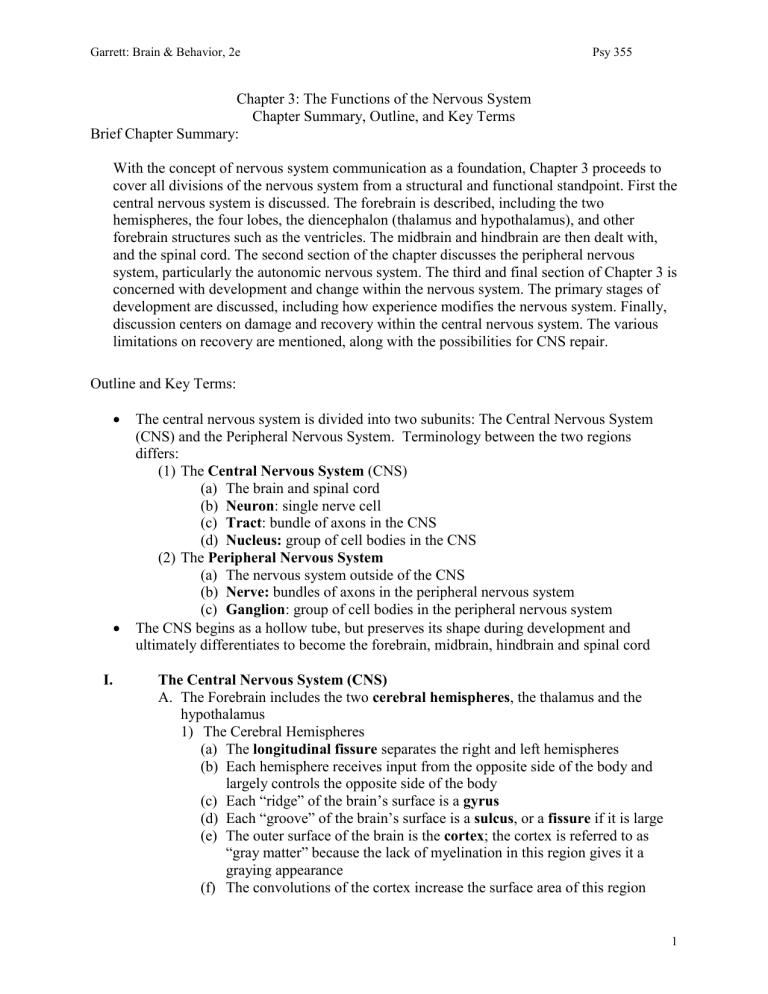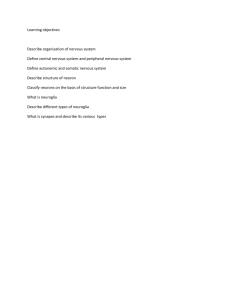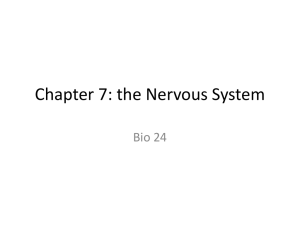Chapter 3

Garrett: Brain & Behavior, 2e Psy 355
Chapter 3: The Functions of the Nervous System
Chapter Summary, Outline, and Key Terms
Brief Chapter Summary:
With the concept of nervous system communication as a foundation, Chapter 3 proceeds to cover all divisions of the nervous system from a structural and functional standpoint. First the central nervous system is discussed. The forebrain is described, including the two hemispheres, the four lobes, the diencephalon (thalamus and hypothalamus), and other forebrain structures such as the ventricles. The midbrain and hindbrain are then dealt with, and the spinal cord. The second section of the chapter discusses the peripheral nervous system, particularly the autonomic nervous system. The third and final section of Chapter 3 is concerned with development and change within the nervous system. The primary stages of development are discussed, including how experience modifies the nervous system. Finally, discussion centers on damage and recovery within the central nervous system. The various limitations on recovery are mentioned, along with the possibilities for CNS repair.
Outline and Key Terms:
I.
The central nervous system is divided into two subunits: The Central Nervous System
(CNS) and the Peripheral Nervous System. Terminology between the two regions differs:
(1) The Central Nervous System (CNS)
(a) The brain and spinal cord
(b) Neuron : single nerve cell
(c) Tract : bundle of axons in the CNS
(d) Nucleus: group of cell bodies in the CNS
(2) The Peripheral Nervous System
(a) The nervous system outside of the CNS
(b) Nerve: bundles of axons in the peripheral nervous system
(c) Ganglion : group of cell bodies in the peripheral nervous system
The CNS begins as a hollow tube, but preserves its shape during development and ultimately differentiates to become the forebrain, midbrain, hindbrain and spinal cord
The Central Nervous System (CNS)
A.
The Forebrain includes the two cerebral hemispheres , the thalamus and the hypothalamus
1) The Cerebral Hemispheres
(a) The longitudinal fissure separates the right and left hemispheres
(b) Each hemisphere receives input from the opposite side of the body and largely controls the opposite side of the body
(c)
Each “ridge” of the brain’s surface is a gyrus
(d) Each “groove” of the brain’s surface is a sulcus , or a fissure if it is large
(e) The outer surface of the brain is the cortex ; the cortex is referred to as
“gray matter” because the lack of myelination in this region gives it a graying appearance
(f) The convolutions of the cortex increase the surface area of this region
1
Garrett: Brain & Behavior, 2e Psy 355
(g)
“White matter” is the myelinated region where axons come together in the central core of each gyrus
(h) Brain size and intelligence are not related across species, and only moderately related among humans
(i) The CNS is arranged in a hierarchy; the more frontal regions are more complex and control more complex behaviors than the rostral ones
2) The Four Lobes
(a) The Frontal Lobe i.
The precentral gyrus contains the motor cortex ii.
The secondary motor cortex is involved in planning movements, and works together with the basal ganglia iii.
Broca’s area
is involved in speech production and contributes grammar to language production and understanding iv.
The prefrontal cortex is the largest, and one of the most important regions of the human brain v.
Lobotomies are a form of psychosurgery that had negative consequences and is now held in disfavor vi.
Psychosurgery has been replaced with other therapies including pharmaceuticals
(b) The parietal lobe is above the lateral fissure and between the central sulcus and occipital lobe i.
The somatosensory cortex contains the skin senses and senses body movement and position ii.
The parietal association cortex helps the person identify objects by touch, determine the location of the limbs, and locate objects in space iii.
Neglect is a disorder resulting from damage to the posterior parietal cortex
(c) The temporal lobe is separated from the frontal and parietal lobes by the lateral fissure i.
The auditory cortex is the primary projection area for hearing ii.
Wernicke’s area
is involved in language comprehension iii.
The inferior temporal cortex participates in visual identification iv.
Stimulation of the temporal lobe by neurosurgeon Wilder
Penfield provoked sounds, music, voices, and memories in patients
(d) The occipital lobe contains the visual cortex
3) The Thalamus and Hypothalamus
(a) The thalamus is located below the lateral ventricles, and receives information from all sensory capacities except smell
(b) The hypothalamus plays a major role in controlling hormone function, emotion, and motivated behaviors
(c) Nearby, the pineal gland secretes melatonin (a sleep-inducing hormone) and is involved in daily rhythms in humans
4) The Corpus Callosum is a dense band of fibers connecting the two hemispheres
2
Garrett: Brain & Behavior, 2e Psy 355
5) The Ventricles are hollow cavities inside the brain, filled with cerebrospinal fluid; enlargened ventricles can indicate reduced brain tissue (overall volume remains the same).
B.
The Midbrain and Hindbrain
1) The midbrain plays a role in vision, audition, and movement
(a) The superior and inferior colliculi are involved in visual and auditory functions, respectively
(b) The substantia nigra integrates movement; degeneration leads to
Parkinson’s disease
(c) The midbrain also includes the ventral tegmental area and reticular formation
2) The Hindbrain is made up of the medulla, pons, and cerebellum
(a) The medulla is responsible for life functions (e.g., breathing)
(b) The pons contains sensory pathways and centers related to sleep and arousal (part of the reticular formation )
(c) The cerebellum controls the speed, intensity and direction of motor movements and may also play a role in motor learning, cognitive processes and emotion
C.
The Spinal Cord is a cable of neurons that carries information from the brain to the muscles and organs, and sensory information to the brain
1) The spinal cord controls routine behaviors such as walking through pattern generators
2) Sensory neurons go into the spinal cord through the dorsal root of each spinal nerve
3) Axons of the motor neurons pass out of the spinal cord through the ventral root
4) Sometimes sensory neurons connect with motor neurons without engaging the brain. This type of connection can produce a simple, automatic movement in response to a sensory stimulus (i.e., a reflex ).
D.
Protecting the CNS
1) The meninges enclose the brain and spinal cord
2) Cerebrospinal fluid nourishes and cushions the CNS
3) The blood-brain barrier limits passage of toxins and neurotransmitters between the brain and the bloodstream
4) The area postrema is located outside of the blood-brain barrier and induces vomiting when toxins are ingested
3
Garrett: Brain & Behavior, 2e Psy 355
II.
The Peripheral Nervous System
The peripheral nervous system (PNS) is made up of cranial and spinal nerves
The somatic nervous system operates the muscles of the body and the sensory neurons that bring information into the central nervous system
The autonomic nervous system regulates general body activity and internal nervous activity (e.g., heart, breathing, etc.)
A.
The Cranial Nerves are concerned with sensory and motor activities within the body
B.
The Autonomic Nervous System (ANS) is composed of two branches:
1) The sympathetic nervous system is responsible for arousal to cope with demands
2) The parasympathetic nervous system is responsible for reducing arousal and restoring energy, e.g., by activating digestion
III.
Development and Change in the Nervous System
A.
The Stages of Development
1) During proliferation the cells that will become neurons divide rapidly
2) These cells then leave the ventricular zone during migration and move to their ultimate destinations
3) During circuit formation, developing neurons send processes to target cells and form functional connections
(a) Axons find other neurons through their growth cones
(b) Neurons that are unsuccessful in finding a place on a target cell die in a process called circuit pruning
(c) Neurotrophins enhance the survival of neurons
(d) Plasticity is the ability of neural systems to be modified
4) Mistakes during development can have serious consequences
(a) Periventricular heterotopia results from the disruption of migration and is caused by a genetic mutation
(b) Fetal alcohol syndrome results from alcohol exposure during migration
(c) Ionizing radiation disrupts proliferation and migration
5) Myelination begins during development and continues into adolescence
B.
How Experience Modifies the Nervous System
1) Reorganization involves a shift in connections that alters the function of an area of the brain, e.g.,
2) Reorganization may be beneficial, as in increases in finger areas in the somatosensory cortex in Braille readers and string musicians, or detrimental, as in phantom limbs
C.
Damage and Recovery in the CNS
1) Limitations on Recovery
(a) Regeneration , the regrowth of severed axons, cannot occur in the mammalian CNS
(b) Neurogenesis the birth of new neurons, occurs only in the hippocampus and near the lateral ventricles
2) Compensation and Reorganization
4
Garrett: Brain & Behavior, 2e Psy 355
(a) Compensation , occurs when uninjured tissue takes over the functions of neurons lost to injury
(b) Reorganization is more dramatic, can involve an entire hemisphere, and is often seen in recovery from language impairment
(c) Hydrocephalus occurs when CSF is blocked and results in retardation
3) Possibilities for CNS repair are being explored by researchers
(a) Attempts to induce growth in damaged spinal neurons
(b) Actor Christopher Reeve personally contributed greatly to the exploration of CNS repair mechanisms through both personal experience and the creation of a private foundation
(c) Stem cells are undifferentiated cells and thus have the potential to repopulate damaged neural tissue
5








